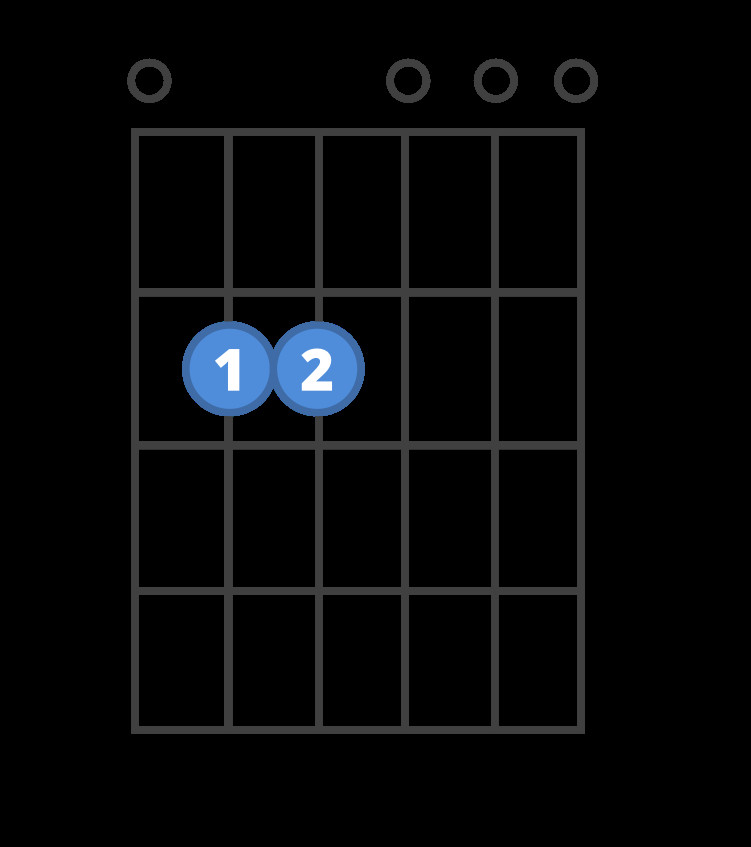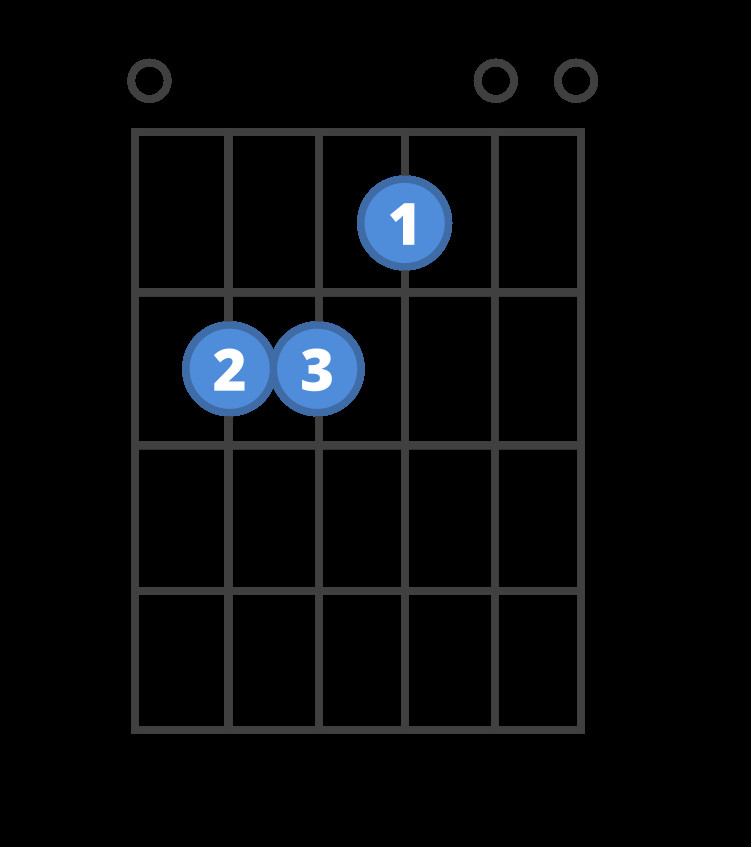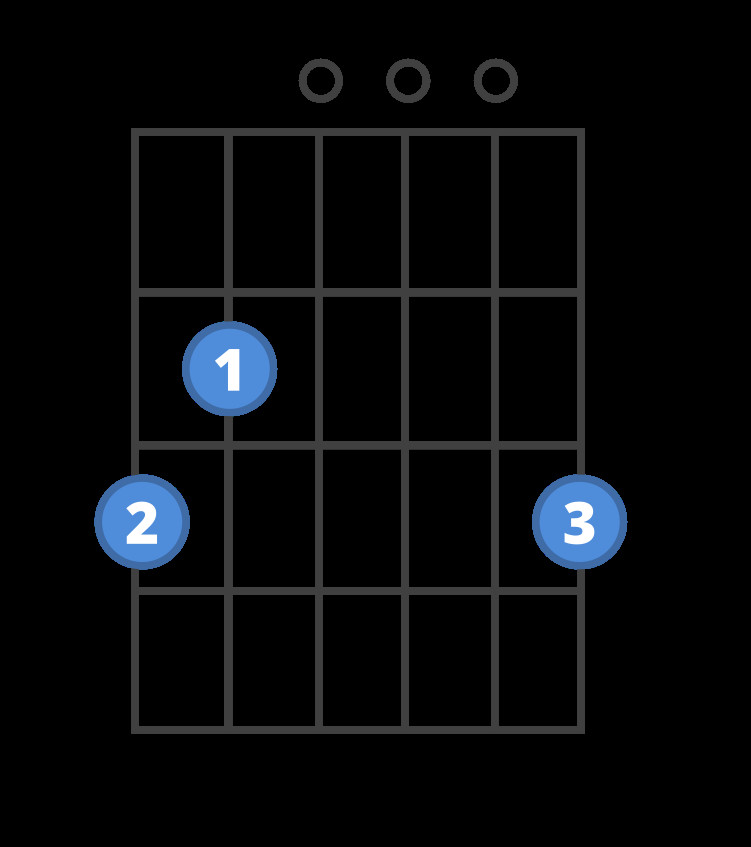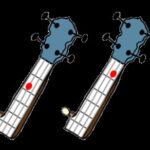The Em chord, also known as E minor, is a foundational chord for anyone starting their guitar journey. It’s celebrated for being one of the simpler chords to learn, yet it unlocks a vast world of songs and musical styles. This guide will walk you through playing the Em chord on guitar, offering practice tips and insights to help you master it quickly.
Getting Your Fingers in Position for Em
Playing the Em chord is delightfully straightforward, requiring just two fingers. Here’s how to form this essential chord:
- Locate the Second Fret: Find the second fret on your guitar’s neck.
- Second Finger on the A String: Place your second finger (middle finger) on the 5th string (A string) at the second fret.
- Third Finger on the D String: Place your third finger (ring finger) on the 4th string (D string) at the second fret.
- Strum All Strings: Strum all six strings from the thickest (E string) to the thinnest (e string). You should hear a clear, resonant minor chord.
 Chord diagram for the Em guitar chord.
Chord diagram for the Em guitar chord.
Many beginners wonder if using the first and second fingers would be easier. While possible, starting with the second and third fingers offers a significant advantage. This fingering leaves your first finger free, making transitions to other common chords like C major, A minor, or D major much smoother. This efficiency in chord changes is crucial as you progress and start playing songs.
Why the Em Chord is a Must-Know for Guitarists
The Em chord isn’t just easy to play; it’s incredibly versatile and frequently used across genres. From classic rock anthems to folk ballads and pop hits, the Em chord provides a melancholic yet powerful sound that adds depth to countless songs. Learning the Em chord early on expands your musical possibilities and allows you to play along with a wide range of music.
Understanding the Difference: Em vs. E Major
If you’re already familiar with the E major chord, you’re very close to mastering Em. The difference is subtle but significant, highlighting a key concept in music theory.
Let’s compare the finger positions and the resulting sound:
Em Chord
 Chord diagram for the Em guitar chord.
Chord diagram for the Em guitar chord.
E Major Chord
 Chord diagram for the E guitar chord.
Chord diagram for the E guitar chord.
The E major chord, on the right, includes an additional finger on the G string (3rd string) at the first fret. This seemingly small change raises the G note to a G#, creating a major third interval instead of a minor third. This single note difference is what distinguishes the bright, happy sound of E major from the darker, more emotive sound of E minor. Understanding this difference is a fundamental step in grasping basic music theory on the guitar.
Effective Practice Techniques for the Em Chord
To truly internalize the Em chord, consistent and focused practice is key. Here’s a highly effective drill to help you memorize the shape and transition smoothly:
The On-Off Drill:
- Form the Em Chord: Place your fingers in the Em chord shape.
- Strum and Count: Strum the chord for four beats, counting aloud to maintain rhythm.
- Release and Rest: Remove your fingers completely from the strings for four beats.
- Repeat: Immediately reform the Em chord and repeat the strumming and release cycle.
This exercise helps build muscle memory for the Em chord shape and improves the speed and accuracy of your finger placement. The pauses between chord formations are crucial, giving you time to consciously reset and ensure correct finger positioning each time.
Once you are comfortable with the On-Off Drill, challenge yourself by switching between Em and another chord. The G major chord is an excellent choice for this, as it’s another common and beginner-friendly chord.
Em Chord
 Chord diagram for the Em guitar chord.
Chord diagram for the Em guitar chord.
G Chord
 Chord diagram for the G guitar chord.
Chord diagram for the G guitar chord.
Practice transitioning back and forth between Em and G, focusing on smooth, rhythmic changes without pausing the beat.
Play Along and Expand Your Chord Vocabulary
Put your Em chord skills into practice with play-along tracks. Start with simple chord progressions featuring Em, G, D, and C. These four chords alone unlock hundreds of songs. Focus on maintaining a steady rhythm and clean chord changes as you play along.
To further expand your musical toolkit, explore other chords that harmonize beautifully with Em. These include:
- G Major
- C Major
- D Major
- A Minor
As you become more comfortable with Em and these related chords, you’ll find yourself capable of playing an ever-growing repertoire of songs. The Em chord is more than just a beginner chord; it’s a cornerstone of guitar playing that will serve you well throughout your musical journey.

